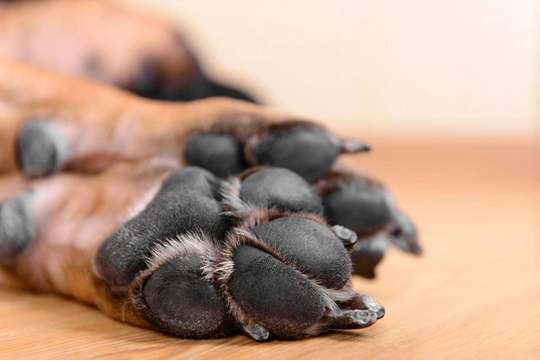
What factors can cause cracked paws in the dog?
The construction of the foot of the dog is significantly different to that of people, and dogs can of course can walk comfortably on all manner of hard surfaces due to their flexible, tough footpads, which help to protect them against soreness and scuffs, and are resilient towards cuts and grazes. However, just because dogs walk barefoot does not mean that their feet are invincible-and there are actually a range of different problems that can affect the paws and pads of your dog’s feet, which can make walking painful and uncomfortable for them.
Cracked paws in the dog is a reasonably common problem, and one that can be very painful and difficult to treat, because you cannot simply put a dog on bed rest and stop them from moving around very effectively! The pads of the paws and the toes usually become dry and hard before cracking, which then makes the feet painful and walking uncomfortable-and there are a range of different things that can cause this to happen.
In this article, we will look at the most common problems and scenarios that can cause cracked paws in the dog, most of which can be prevented to stop a problem from developing in the first place.
Read on to learn more about the factors that can cause cracked paws in the dog.
Health conditions and breed tendencies
First of all, most cases of cracked paws will occur due to environmental factors, which we will get to in a minute-but dry and cracked paws can also occur as a result of certain health conditions too, and it is important to rule these out, and get your dog’s feet checked by your vet to make sure that there is not a larger problem at the root of the issue.
A hereditary condition called hyperkeratosis can lead to the pads of the paws and the toes becoming thicker and harder than they should be, which increases the risk of dryness and splitting, but if you know that your dog has the condition, it can be managed on an ongoing basis.
Additionally, some breeds of dogs that tend to be lean and slender, like the Greyhound, have finer, thinner skin on their paws and toes than most other dogs, which places them at higher risk of cracks to the footpads and other related problems. Knowing the heightened risks for certain breeds can help you to protect your dog’s feet, and keep them in good condition.
Cold and wet weather
Many of us suffer from dry skin, particularly on our hands, during the winter-and the same factors can affect the pads of your dog’s paws too. Cold, wet conditions can weaken the foot pad and make cracking and splitting more likely, and if your home has central heating, transitioning from the cold and wet and into a dry heat after walks can further contribute to the problem.
Always dry your dog’s feet off when you get back in from walks and if necessary, use booties to protect your dog’s feet when out walking in ice, snow and cold weather. Also, try to ensure that your home environment is not overly dry, and that your dog’s feet remain supple by using protection such as paw wax or other creams if necessary to improve the condition of the skin.
Hard or harsh surfaces
Walking your dog for long periods of time over very hard or harsh surfaces such as hardcore or tarmac can lead to abrasions and cracks on the paws. Walking on hard surfaces regularly will help to keep your dog’s feet hard and tough, but if your dog is not used to it, it can lead to soreness and damage.
Try to vary your dog’s walks between walking on hard surfaces to toughen up the feet and keep the claws short, and walking on softer surfaces to provide some relief. Again, use booties if your dog needs a little extra protection, or you are planning a longer walk or are going somewhere where you are not sure about the conditions.
High impact activities
High impact activities and vigorous exercise that involves lots of running around, jumping and turning are all really good for active, healthy dogs, but you must again make sure that the surfaces that they undertake such exercise on are good for them and do not damage their feet.
Making fast turns, running at speed or jumping and skidding on rough or harsh surfaces like gravel can lead to abrasions on the paws, which will be painful and can lead to cracks when they scab over, so limit high impact activity to softer, more forgiving surfaces such as grass.
Dehydration
Finally, healthy, supple skin depends on hydration, and if your dog spends a long time dehydrated or gets dehydrated regularly, they will not have enough fluid in their bodies to support healthy functions, which can lead to the skin on the paws drying out and becoming more prone to cracking.
Ensure that your dog has free access to fresh, clean water at all times, and take some water with you to give to your dog when you are out on longer walks too to replenish their resources!



